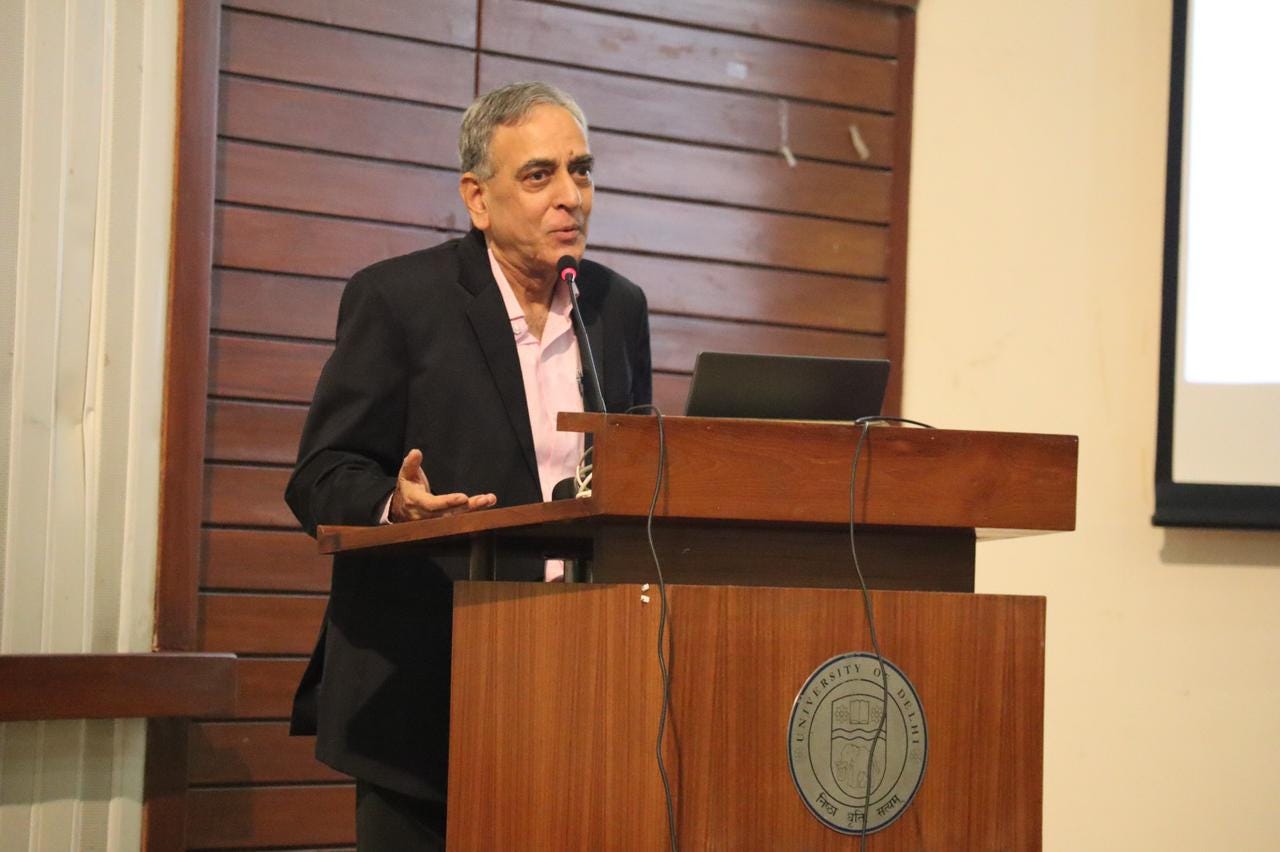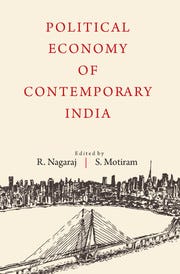Why is Manufacturing Declining in India
Lack of local investors and western funds pursuing short-term profits are among factors crippling manufacturing in India says Rayaprolu Nagaraj
(Photo: Rayaprolu Nagaraj )
A Global Indian Times Interview
By Cherian Samuel*
Rayaprolu Nagaraj’s research paper, “India’s premature deindustrialization and Falling investment rate in the 2010s”, will be published in July by World Development. For the past several decades, he has analyzed India’s industrial economy and served on several policy committees advising the Government of India.
Nagaraj has edited several books, including: Growth, Inequality and Social Development in India: Is Inclusive Growth Possible? (2012); Political Economy of Contemporary India (with Sripad Motiram, 2017); and Industrialization for Employment and Growth in India: Lessons from Small Firm Clusters and Beyond (2021). He also writes for research journals and other publications, including opinion pieces in newspapers.
From 1992 to 2020, Nagaraj was a Professor in Economics at the Indira Gandhi Institute for Development Research (IGIDR), Mumbai. He was a Visiting Professor at Princeton University, U.S., in 2007 and 2008 as well as at Hosei University, Tokyo, 2001-02. Earlier he was at the Institute for Public Enterprises, Hyderabad, India, 1985-1992. Nagaraj earned an MPhil in 1980 and PhD in 1989 from the Center for Development Studies (CDS), Trivandrum, Kerala; also, an MA in Economics at the Birla Institute of Technology and Science (BITS), Pilani, Rajasthan.
In a conversation with Global Indian Times, Nagaraj spoke about the decline of manufacturing in India, the rapid rise of the Ambani and Adani industrial groups, urban unemployment, dependence on Chinese imports, and why the short-term profit goals of foreign funds do not benefit India.
Global Indian Times: Congratulations on the publication of your research paper on India’s premature deindustrialization. Why does it matter?
Rayaprolu Nagaraj: Deindustrialization occurred in advanced economies such as the United States and Japan when output and employment in manufacturing declined. But this was after the countries attained high per capita income and industrial maturity. In contrast, premature deindustrialization applies to many developing economies where manufacturing employment and output declines well before they attain high levels of per capita income. Since the early 1980’s, many Latin American and African countries, like Brazil, have gone through premature deindustrialization.
India appears to be on the same path since the 2010s. It matters because the economy has failed to move into high-productivity manufacturing and services - the defining feature of modern economic growth, as outlined by the economist Simon Kuznets.
Information technology and outsourced services are shining examples of India’s success. But they at best employ five million workers out of total workforce of over 450 million.
GIT: How is deindustrialization related to jobless growth in India?
Nagaraj: The deceleration in industrial growth has led to a drop in manufacturing jobs. This pushed many workers to migrate back to their villages where they try to farm for survival.
For instance, contrary to the projections of liberal reforms policies, the share of labor-intensive textile exports in India’s total exports declined sharply: from about 25% in the mid-1990s to roughly 8% in fiscal year 2022-23.
Meanwhile, textile exports rose in Bangladesh and Vietnam, boosting employment in those countries
GIT: One of your key findings is about India’s rising imports from China during the 2010s. Why did this happen?
Nagaraj: Imports from China have risen across the board, from toys and cellphones to electronics hardware and traditional capital goods like industrial machinery. India prioritized consumption including with easier access to consumer credit. Providing easy access to electronic goods was also perhaps driven by the Digital India policy agenda.
I guess that, in many industries, an inverted duty structure – higher tariffs on imports of intermediate goods than on final goods – may have deterred domestic investment, while contributing to the boom in imports. However, there are differing views on this.
Many of India’s bilateral free trade agreements, which allow duty-free imports especially from southeast Asian countries, could have taken away incentives for domestic industrial investment. Similarly, duty-free imports of capital goods for super-thermal power plants and large infrastructure projects could also have added to the disadvantages for domestic machinery manufacturers.
GIT: Is India less or more dependent on Chinese imports today?
Nagaraj: More dependent. As I have shown in my paper, India’s dependence on Chinese imports and the bilateral trade deficit has steadily risen for more than a decade. China emerged as India’s largest trading partner in fiscal year 2023-24.
GIT: Another finding is the sharp decline in investment and savings in India. Assume this has caused the drop in domestic capital accumulation needed for the country to industrialize. Why the decline?
Nagaraj: Yes, this has been my concern. During the 2000s, domestic investment in India reached about 37 percent of GDP, catching up with the level in the fast-growing East Asian Economies like South Korea.
But, over the following decade, the investment rate declined precipitously. Many attributed this to the unwillingness of the major banks, which are mostly government-owned, to make fresh loans to private corporate companies. The banks were already burdened by sharply rising bad debt from their previous loans. However, this hypothesis seems suspect since bank lending did not revive even after the Government wrote off most of the bad loans carried by the banks. So, the problem perhaps lies elsewhere.
GIT: You also found that foreign direct investment inflows, mainly from the US and other Western countries, declined in the 2010s. Why?
Nagaraj: Yes, foreign direct investment, as a ratio of GDP, declined during the last decade, after peaking in 2008. Government policies have failed to attract foreign funds which focus on long-term capital investments, providing new technologies, and expanding industrial capabilities. Policy makers view foreign investments mainly as a means to manage the country’s balance of payments; not as an instrument for raising capital and boosting industrial production.
GIT: You say that about three quarters of foreign investments was for existing rather than new projects. Was this because the profits earned are higher on existing projects? Also, assume the investors seek to avoid the business and political risks of new projects?
Nagaraj: Most of the foreign investment is from private equity or venture or hedge funds. Typically, they do not invest in new projects. They acquire operating businesses with the goal of selling them at a good profit in three to five years. The economic benefits, let alone social benefits, of such investments are open to question.
GIT: Your analysis points to the failure of major government initiatives, like Make in India. Is this because Indian capitalists do not have the funds? Or because the potential profits they could earn are not attractive?
Nagaraj: Government efforts to promote manufacturing have been misdirected. For six years, the Make in India policy focused on improving India’s ranking in the World Bank’s Ease of Doing Business Index. It is a dubious index. There is no co-relation between improvement in a country’s index ranking and its ability to attract local investments and foreign funds.
Another scheme, the Production Linked Incentive, sought to encourage low-valued added assembly work by offering enormous subsidies. It has not led to any meaningful rise in capital and intermediate goods manufacturing. Investors and owners of such projects risk very little of their own capital. So they can exit quickly to pursue a more profitable opportunity elsewhere.
GIT: Why have the Ambani and Adani Indian industrial groups grown immensely?
Nagaraj: Economic reforms initiated in 1991 were supposed to be pro-market, ushering in greater competition and generating a virtuous growth cycle. But it turned out that the reforms were mainly pro-big business, giving rise to Bollygarchs, to use James Crabtree’s term for Indian oligarchs (in his book, The Billionaire Raj, 2018.)
The reforms ushered in Crony Capitalism or Crony Oligarchy. The pecking order of the oligarchs may have changed. But the policies enabled the oligarchs to grow bigger and stronger. Apparently, some of them have a stranglehold on critical industrial inputs, throttling the competitiveness, for instance, in labor-intensive manufacturing such as textiles.
GIT: You state that India needs an industrial policy. How can the lack of domestic investment be solved?
Nagaraj: Like its Asian neighbors, household savings in India is high, around 30 percent of GDP. The saving rate needs to be quickly raised to about 37 percent by offering incentives to the savers. The savings can be supplemented by policies which ensure that foreign funds mainly invest in new projects, which bring advanced technologies, import substitution, global distribution as well as modern managerial practices.
GIT: Your views on the role of the government-owned public sector companies in the Indian economy?
Nagaraj: Since India’s independence (in 1947), the public sector has been entrepreneurial in introducing new technologies. More important, unlike India’s capitalists, they had to undertake the risks of large-scale investments in major infrastructure projects like power, energy, coal, iron, and steel.
Even now, government investments, through public sector companies, dominate the energy and infrastructure industries. The public sector must continue to play a substantial role in developing new capital intensive industries and technologies.
GIT: What is the future of India’s small-scale industries?
Nagaraj: Small-scale industries account for about a third of manufacturing value added, while employing more than two thirds of the industrial workforce. Small businesses will have a bright future if policies offer them attractive funding, similar to that given to the Bollygarchs. They also need better infrastructure and wider distribution channels for their products.
GIT: Would you characterize your World Development paper as a summary statement of your view of the Indian economy?
Nagaraj: Yes. In the paper, I have updated the data to ensure that my arguments have firmer empirical evidence. It will be part of a forthcoming special issue on India’s political economy, edited by Louise Tillin, Soumya Mishra, Sunil Mitra Kumar, and Christophe Jaffrelot. It will consist of papers presented at a conference at Kings College, London, in June 2023. I owe it to Louise for persuading me to prepare the manuscript for publication.
GIT: Why did you choose to study economics? Economists who have shaped your thinking?
Nagaraj: As you know, most young men from middle class families in India, want to be doctors or engineers. I too joined BITS in Pilani to study engineering. But after spending two years in Pilani (a small-town in Rajasthan, India) and the neighboring villages, I wanted to study how India could develop its economy. So, I switched to studying economics. In those early years, the economists who influenced me were Gunnar Myrdal, W Arthur Lewis, and K.N. Raj.
GIT: What are your thoughts on the current state of the economics profession in India?
Nagaraj: Economics teaching and research has become much more widespread now than in the 1980s. This is in large part due to the rising demand for insights on consumer spending and behavior which is sought by businesses. There is little opportunity for other economic studies, like the empirical work to formulate policies, which I pursued as a student at the Centre for Development Studies (India). Instead, there is an enormous expansion of training in quantitative methods. Economics research has become results-oriented – some of which is welcome.
Joseph Schumpeter said that one must know theory, history, and statistics to be a good economist.
GIT: As you look back on your career as an economist, what gives you the most satisfaction?
Nagaraj: I mostly did independent research on contemporary economic problems in India. On average, I published two single-authored papers per year and taught one course. I also did policy-related work and taught at a few leading universities in the US and other countries. It is satisfying that most of my work is cited in academic literature and has become part of teaching and policy discourse.
*Cherian Samuel, a writer based in Washington DC, retired from the World Bank. He earned a PhD in economics from the University of Maryland.
To SUBSCRIBE to Global Indian Times, send email address to: gitimescontact@gmail.com



